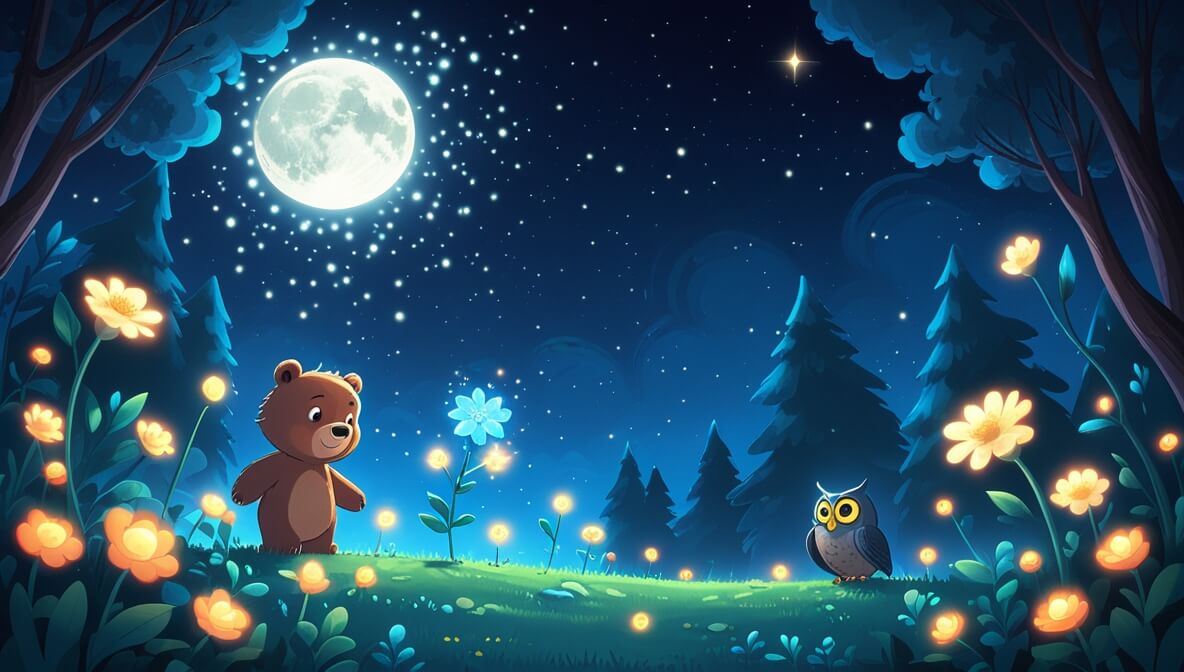Under the twinkling stars, a tiny bear named Pippin goes on a bedtime adventure to find the glowing Moonflower in the enchanted garden. With his friend, a wise little owl named Luna, they discover the magic of night.
Age Recommendation
0 – 4 years
Characters
Characters:
- Pippin the Bear (a curious little bear with a heart full of adventure)
- Luna the Owl (a wise owl who loves to help others)
Story
Once upon a time, in a cozy corner of the forest, there lived a little bear named Pippin. Every night, as the stars began to twinkle, Pippin’s eyes would grow wide with wonder. He always wanted to find the magical Moonflower that bloomed only in the enchanted garden.
The Nighttime Whisper
One moonlit evening, Pippin heard a soft whisper. “Follow the light, find the bright,” it said. Pippin knew it was Luna the Owl, his wise friend. Luna fluttered down from her tree branch and perched beside Pippin. “Let’s find the Moonflower together,” she hooted.
The Enchanted Garden
They wandered through the forest, following the twinkling stars. Soon, they reached the enchanted garden, where flowers glowed like tiny lanterns. “Look, Pippin!” squeaked Luna, pointing to a glowing flower. “The Moonflower!”
The Magic of Friendship
Pippin and Luna watched as the Moonflower opened its petals, releasing sparkles into the night. “It’s beautiful,” whispered Pippin. With a grateful heart, he hugged Luna. “Thank you for coming with me,” he said. Luna smiled, “Friends always help each other.”
The end.
Moral of the Story
Friendship and teamwork can make any adventure magical and more fun. Always be there to help your friends, just like Luna helped Pippin.
Questions to Think About
- What do you think made Pippin want to find the Moonflower?
- How did Luna help Pippin on his adventure?
- Why is it nice to do things with friends?
- What other adventures do you think Pippin and Luna could have?
- What do you imagine the Moonflower looks like?
Do You Know
- Owls are known for being very wise and can see well at night.
- There are flowers that actually bloom at night, sometimes called “moonflowers.”
Word Explorer
- Enchanted: Filled with magic or wonder
- Twinkle: To shine with a sparkling light
- Whisper: To speak very softly
Emotions in the Story
- Curiosity: When Pippin wanted to find the Moonflower.
- Excitement: When Pippin and Luna found the enchanted garden.
- Joy: When the Moonflower bloomed and Pippin hugged Luna.
Color Your Scene
Imagine the enchanted garden with glowing flowers. Draw Pippin and Luna standing under the stars, with the Moonflower sparkling in the middle. Use lots of blue for the night sky and bright colors for the flowers.
Parents’ Corner
This story is a wonderful way to introduce the concepts of:
Friendship: Encourage your child to think about how friends can support each other, just like Pippin and Luna.
Exploration and Curiosity: Discuss how Pippin’s curiosity led to new discoveries and how being curious is a wonderful trait.
Nighttime Wonders: Talk about the beauty of the night, the stars, and nature’s magic, fostering a sense of wonder and imagination.
Helping Others: Emphasize the importance of helping and being there for friends, which can lead to magical experiences.











